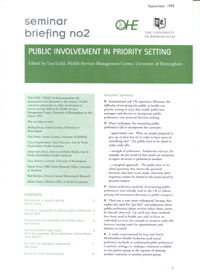International and UK experience illustrates the difficulty of involving the publica in health caare priority setting in ways that enable politicians, managers and doctors to incorporate…
International and UK experience illustrates the difficulty of involving the publica in health caare priority setting in ways that enable politicians, managers and doctors to incorporate public preferences into practical decision making. Many techniques for measuring public preferences fail to incorporate key concepts:……
-
International and UK experience illustrates the difficulty of involving the publica in health caare priority setting in ways that enable politicians, managers and doctors to incorporate public preferences into practical decision making.
-
Many techniques for measuring public preferences fail to incorporate key concepts:
-
opportunity cost. What are people prepared to give up or have less of, in order to have more of something else? The public have to be asked to make trade-offs;
-
strength of preference. Satisifaction surveys, for example, do not reveal by how much one treatment or aspect of service is preferred to another
-
a managerial approach. The public have to be asked questions that mirror the practical decisions that have to be made, otherwise their responses cannot be related to the issues faced by decision makers.
-
Stated preference methods of measuring public preferences were initially used in the UK to inform pricing and investment decisions in public transport.
-
Their use is now more widespread, because they replace the need for ‘gut feel’ and judgement about public preferences about services where these cannot be directly observed. Up until now these methods have been used in health care only to focus on individual services, for example to measure trade-offs between waiting times for appointments and distance to travel.
-
A sudy commissioned by East and North Hertfordshire Health Authority used stated preference methodfs to understand public preferences in priority setting, i.e. making a treatment available to one patient group at the expense of denying another treatment to another patient group.
-
The results hace to be interpreted with care but suggest that treartment for individual patients that cost more than £100,000 were rarely supported, whilst those costing below £70,000 were usually supported. The public did not always prefere choices that maximised health gain, sometimes preferring treatments that provided simply a good quality life.
-
Stated preference methods often involve the use of qualtitative research, to help identify the key issues of concern to the public, to pilot the types of questions to be asked, and, after the quantitative component of the study has been completed, to help the researchers understand and interpret the results.
-
However, this assumes that preferences exist,are complete and are stable. It is likely that people’s choices are partially constructed during the process of answering questions, which requires researchers to ensure that people have time to reflect before answering questions. Qualitative research should be used to ensure that quantitative results are valid and that the underlying reasons for the trade-offs are understood.
-
All attempts to involve the public in health care priority setting must accord the public respect. Whilst the views of the public will only ever be one of many criteria informing resource allocation, the results of research exercises involving the public must be seen to inform the decisions that are made. Stated preference methods, incorporating the effectice use of qualitative research, offer an appraoch that can provide measured preferences in a way that directly addresses the decision to be taken. This enables a direct link to be established between the views of the public and their impact on the decision making process.

